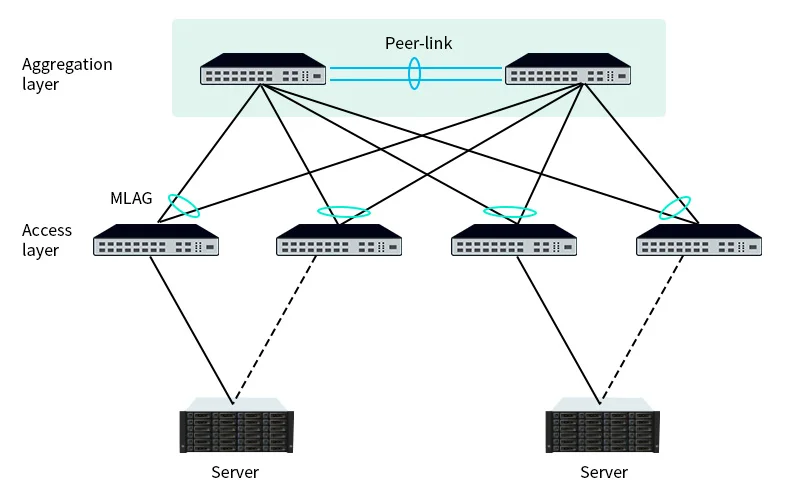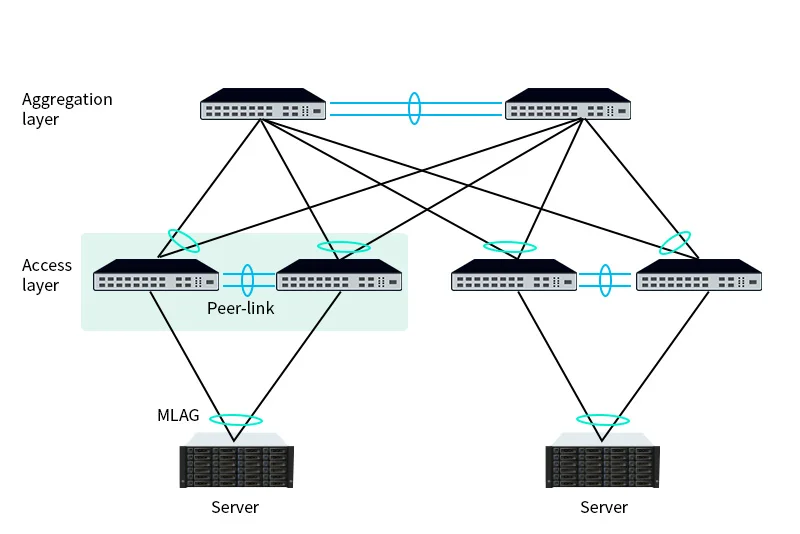Multi-Chassis Link Aggregation (MLAG) is a crucial virtualization technology to enhance load balancing and reliability. This article delves into the meaning, importance, and potential use cases of MC-LAG across various network levels. It concludes by addressing frequently asked questions to ensure a thorough grasp of its role in modern networking.
Before delving into MLAG, let's first explore what LAG is.
LAG can enable the amalgamation of multiple physical Ethernet interfaces into a unified logical interface. This allows for increased bandwidth and reliability by combining several lower-bandwidth Ethernet links into a higher-bandwidth link. LAG addresses the growing demands for data transmission, enabling more efficient network performance.
LAG also provides link redundancy, allowing other links to continue functioning in the event of a failure in one of the links, thereby enhancing network reliability. Furthermore, LAG enhances traffic distribution by evenly spreading traffic across the aggregated links, thereby improving overall link utilization.
MLAG, short for Multi-Chassis Link Aggregation, is a technology within computer networking aimed at enhancing network redundancy and availability. It enables multiple switches to collaborate as a unified logical switch, offering redundancy at both link and switch levels.
In traditional link aggregation setups, multiple physical links are grouped between switches or between a switch and a server to boost bandwidth and provide failover capabilities. However, in a standard LAG configuration, all links in the group typically connect to a single switch.
Afterward, MLAG technology optimized this. This is accomplished by coordinating forwarding states between the switches, facilitating the sharing of information about connected devices, and ensuring equitable distribution of traffic across the links.
MLAG is often used in data center environments where high availability and redundancy are critical. If one switch fails, the other switch in the MLAG pair can continue to handle the traffic, minimizing downtime. This technology helps enhance the reliability and resilience of network architectures.
In the past few years, M-LAG has gained significant popularity as a virtualization technology; however, its development did not occur abruptly.
Conventional data center networks employ redundant devices and links to ensure optimal reliability. To address challenges like underutilized links and expensive network upkeep, the implementation of stacking technology enables the virtualization of numerous data center switches into a single switch. This approach streamlines network deployment while also minimizing associated maintenance expenses.
To address the needs of increasing service traffic and enhancing network dependability, M-LAG virtualization technology has been devised. The advantages of using MLAG are continued below.
MLAG significantly improves network resilience by eliminating single points of failure. With the ability to distribute traffic across multiple links and switches, the network becomes more fault-tolerant, ensuring continuous operation even in the face of hardware or link failures.
Efficient load balancing is crucial for optimizing network performance. MLAG intelligently distributes traffic across available links, preventing congestion and ensuring a smooth and balanced flow of data. This not only enhances the user experience but also maximizes the utilization of network resources.
MLAG ensures that upgrading one switch does not affect the operation of the other, improving network reliability.
MLAG is typically used in virtualized environments to provide redundancy for virtual networks. It integrates well with virtualization technologies and cloud computing platforms, providing a more flexible and reliable infrastructure.
With the MC-LAG, network connectivity can be established between the aggregation and access layer switches. This eliminates the need for STP (Spanning Tree Protocol). In comparison to conventional STP breakpoint protection mechanisms, this design offers improved clarity in terms of logical topology and enhances link utilization efficiency. When it comes to MC-LAG paired devices, there exists independence between their control plane and management plane while only coupling their protocol planes. Theoretically speaking, this configuration ensures higher reliability compared to stacking methods. (Recommended Reading: Switch Stacking vs. MLAG) Additionally, it grants users individual device upgrade capabilities which greatly simplifies maintenance procedures.

The following scenario demonstrates the deployment of MLAG on access switches. In this situation, a server is connected to two access switches through two NICs operating in active-active mode. The server's two NICs utilize the same MAC address and employ flow-based load balancing. Consequently, the ports linked to the server are configured as Eth-Trunk via MLAG, ensuring synchronization of both MAC address and ARP entries for these ports.

Q: Is MLAG the same as LACP?
A: No, MLAG (Multi-Chassis Link Aggregation) and LACP (Link Aggregation Control Protocol) are not the same. The primary objective of MLAG is to ensure system-level backup in case one of the chassis encounters a failure. LACP facilitates the consolidation of multiple physical ports into one logical channel.
Q: How to deploy MLAG?
A: The following are general steps for deploying MLAG:
Choose the right hardware and make sure your switches and network devices support M-LAG.
Configure two peer switches in MLAG peer mode and connect them.
Configure the appropriate ports as MLAG port groups and connect to network devices.
Test and validate: Ensure MLAG functions as expected, providing desired link aggregation and redundancy, by testing and validating its performance.
Monitor and maintain: Regularly monitor MLAG's operational status, promptly address faults and maintenance needs, and maintain its stability and reliability.
Q: What do I need to be aware of when deploying MLAG?
A: Ensure the reliability and redundancy of peer links to guard against single points of failure.
When setting up MLAG peer switches, it is crucial to maintain consistent configurations between the two peers to ensure the proper operation of MLAG.
Regularly monitor the performance and operational status of MLAG, promptly addressing any faults or performance issues.
When configuring MLAG, ensure compatibility with other network technologies and protocols, such as VLANs, STP, etc.
When configuring MLAG, adhere to the manufacturer's best practices and recommendations to ensure security and stability.
Q: What are the drawbacks of MLAG?
A: Configuration Complexity: The setup of MLAG involves a relatively intricate configuration process, demanding the appropriate configuration of links and port aggregation between the peer switches. Incorrect configuration can lead to network failure or performance degradation.
There is a strong dependence on the high-speed interconnection link between MLAG peer switches. If this link fails, it can lead to network outages or instability.
Limited Interoperability: As MLAG is a dedicated link aggregation technology, there might be interoperability challenges with devices from various vendors, constraining the selection of devices and reducing deployment flexibility.
Contact: Mr.Tony
Phone: +86-13418458707
E-mail: support@glovion.com/ tony@glovion.com
Add: No. 42 North Pinchuangyuan Industrial Park Industrial East Road, Longhua Street, Longhua District, Shenzhen